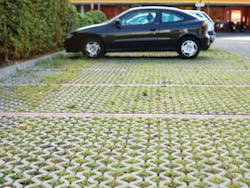Design Review and Simulation Tool for Permeable Pavement and Bioretention
As concerns grow over the negative impacts of urban development on water resources, low-impact-development (LID) practices, such as bioretention and permeable pavement, are increasingly becoming recommended or required. Historically, these practices have been implemented more frequently in areas with predominantly sandy soils, such as the North Carolina Coastal Plain, where generally high infiltration rates can reduce the need for underdrains and improve overall hydrologic function. As interest in LID implementation increases and expands beyond these historical extents, many designers, property owners, regulators, and other stakeholders who may be unfamiliar with permeable pavement and bioretention are being asked to make decisions regarding the use of these systems to manage stormwater runoff. To address this issue, an educational computer tool was developed to assess and illustrate the hydraulic and hydrologic function of bioretention and permeable pavement systems while also evaluating compliance with key design constraints.
The design review and simulation tool was developed with the primary goal of educating users about bioretention and permeable pavement design and function, supporting more informed consideration of implementing these practices, especially in new areas. In support of this goal, a major consideration during development was ensuring that the tool was accessible to users with varying backgrounds and presented pertinent calculations and results in a clear and understandable manner. As a result, the tool was not intended to serve as a comprehensive permeable pavement or bioretention design tool or a detailed model of system performance; however, it was designed to rely upon sound hydrologic and soil hydraulic principles to provide meaningful results.
The design review and simulation tool is a standalone application incorporating a number of features to improve functionality, including the ability to save and open input files, generate printable reports, easily redistribute pertinent files, and provide context-sensitive help throughout. The program comprises two main elements, a tool to assist in evaluating specified designs and a tool to simulate basic system hydrology. The design review aspect of the tool compares input design characteristics to regulatory requirements and common design practices and recommendations, and provides supporting calculations and explanations for those requirements. To improve the transparency and educational aspects of the tool, elements were incorporated to display step-by-step calculation procedures for key design evaluations. Parameters calculated by the tool include bioretention surface area and permeable pavement aggregate depths required to treat the water quality volume, underdrain sizing calculations, and bioretention drawdown durations.
Many of the design criteria evaluations are conducted through the use of conditional statements within the program, comparing input design parameters to established ranges or requirements. Within this framework, it is possible to adapt the tool to local requirements, including variations in acceptable ranges for design parameters, or the existence of different requirements altogether. Potential issues identified with the input design characteristics are illustrated in several manners, providing immediate feedback as design parameters are entered through highlighted input boxes, as well as messages, lists, and printable reports to provide additional detail on the nature of elements identified as potential concerns and rationale behind specific design guidelines.
To educate users on basic system functionality, a design storm simulation was incorporated into the tool. Although simulation methodologies exist to approximate unsaturated flow through soils and address factors such as water table elevation, rainfall patterns, and detailed soil properties, the input data required for many of these procedures conflicted with the accessibility goals of the tool. Consequently, simulations are based upon standard water balance evaluations and core hydrologic and hydraulic calculations. This methodology not only reduced the necessary background information needed to examine basic system functionality, but also improved the accessibility of the tool by using procedures with which users were more likely to be familiar.
Permeable pavement simulations assume that direct rainfall is the only contributing water source, with the rainfall pattern based upon Natural Resources Conservation Service (NRCS) hyetographs using a mathematical model presented by Froehlich (2009). NRCS unit hydrographs are utilized to simulate bioretention inflow. For both bioretention and permeable pavement, a water balance is evaluated at the system surface and subsoil interfaces for each simulation time step. Movement of water into the bioretention soil and into the subsoil of both systems is calculated using Darcy’s Law, assuming saturated conditions. While this assumption underestimates infiltration rates during the initial wetting of the soil, the required input data to perform these calculations are minimal and generally represent a conservative estimate of overall system functionality. Movement of water into the permeable pavement system is governed by a specified infiltration capacity.
Outputs from the hydrologic simulations include a numeric summary of design storm hydrology, including surface runoff or overflow, underdrain outflow, and seepage; an animation of storm hydrology and water level within the practice over time; and a detailed table time series of simulation results. Simulation results not only allow for an illustration of basic system performance, but also allow the user to examine the relative impact of various design elements on storm hydrology.
Due to the manageable computational requirements for the hydrologic simulations, it was possible to utilize the analysis framework incorporated into the design review and simulation tool to evaluate permeable pavement performance over a large geographic area. This approach was used to simulate the hydrology of permeable pavement installations throughout North and South Carolina. GIS data for representative soil hydraulic conductivities throughout these states were obtained from NRCS (2011a and 2011b) based upon hydrologic soil group, while spatial variations in one-year, 24-hour precipitation depths were obtained from the National Oceanic and Atmospheric Administration (NOAA 2006). These GIS data were processed to provide saturated hydraulic conductivity and design storm precipitation depths over North and South Carolina at a 0.5-mile grid spacing. Assigned hydraulic conductivities varied from 0.3 inch per hour for group A soils to 0.025 inch per hour for group D soils. In combination with static design parameters, such as surface infiltration capacity, aggregate porosity, and the height of the underdrain above the subsoil, this simulation framework was used to calculate the proportion of total rainfall lost to seepage into the subsoil and display this information in a map format. Although not accounting for numerous site-specific factors affecting the feasibility of permeable pavement installation, this analysis provided a basic illustration of the potential hydrologic benefits permeable pavement could provide, identifying areas suitable for further evaluation. Results of permeable pavement simulations indicated that the majority of rainfall from a one-year, 24-hour design storm could seep into the subsoil below a permeable pavement system throughout much of North and South Carolina, when simulating a system with an underdrain invert 1 inch above the subsoil (Figure 1).
When implementing LID practices, it is often desirable to maximize the runoff volume reduction these systems provide. One mechanism for increasing the volume reduction capacity of a permeable pavement system is through the incorporation of a sump or storage layer below the underdrain. This layer provides internal storage within the system when the infiltration capacity of the subsoil has been exceeded, without immediately discharging flows to the underdrain system. Simulation results demonstrated that increasing the depth of gravel storage below the underdrain from 0.5 inch to 2 inches resulted in substantial increases in the portion of design storm rainfall infiltrated into the subsoil throughout both North and South Carolina (Figure 2).
As concerns related to post-development hydrology continue to grow, there is a need for effective management strategies, such as LID. Based upon simulation results, permeable pavement and bioretention can provide substantial reductions in runoff volume, even in areas where sandy soils are not predominant, provided other site-specific criteria are satisfied. Particularly in areas where these practices have not been historically implemented, an understanding of important design constraints and system function is imperative. Through the use of design review and basic simulation tools similar to the one presented here, it should be possible to educate designers, property owners, and regulators about these practices, allowing for more informed evaluations of the hydrologic benefits these systems may provide.


